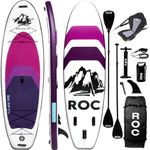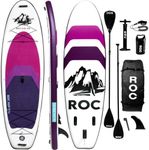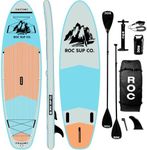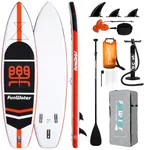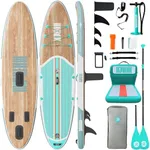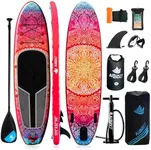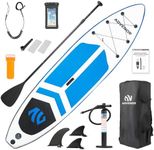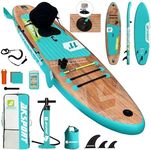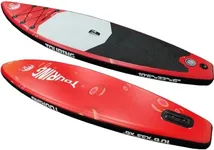Buying Guide for the Best Paddle Boards
Choosing the right paddle board can make a huge difference in how much you enjoy your time on the water. It’s important to look beyond just choosing the most popular or stylish model – think about how and where you want to use your board. Your skill level, the places you paddle, and what kind of experiences you’re hoping for should all shape your decision. Learn about the main features and how they’ll affect the performance and feel of your ride to end up with a board that truly fits your needs.Board TypeThere are several types of paddle boards, such as all-around, touring, racing, yoga, fishing, and surf. This spec is crucial because each type is designed for a different style of paddling and environment. All-around boards are versatile and great for beginners, touring boards are longer for speed and distance, racing boards are slim and fast, surf paddle boards are shorter for maneuverability in waves, and some are made wide and stable for yoga or fishing. Consider what activities or locations you want to explore—if you want to try a bit of everything, start with an all-around board; for long-distance adventures, look for a touring board.
LengthThe length of a paddle board influences its speed, stability, and ability to turn. Shorter boards (under about 10 feet) are easier to control and ideal for surfing or kids, medium boards (around 10 to 12 feet) are great for general use and beginners, while longer boards (over 12 feet) track straighter and move faster, which is useful for touring or racing. Think about your main use—shorter for play and agility, longer for straight tracking and speed.
WidthWidth plays a major role in the board’s stability. Wider boards (over 32 inches) are more stable and are great for beginners, yoga, and those who want to fish from their board. Medium width boards (around 30-32 inches) balance stability and speed, while narrower boards (28-30 inches) move faster but are a bit less stable, which suits experienced paddlers or racers. If you’re new, or want to do activities like yoga, go wider; if you’re after speed or already have great balance, go a bit narrower.
ThicknessBoard thickness affects buoyancy and how much weight the board can support. Thicker boards (usually 5 to 6 inches) can hold more weight and are stiffer, which is great for heavier paddlers or when carrying extra gear. Thinner boards (around 4 inches) sit lower in the water and can feel less stable, but may be preferred by lighter paddlers or for surfing. Match the thickness to your weight and activities; if unsure or if you plan to carry gear, thicker is usually safer.
Weight CapacityThis spec tells you how much total weight the board can carry without sinking or losing performance. It’s crucial for safety and performance—being over the recommended limit will make the board unstable and slow. Always add up your weight and any cargo (like pets, kids, or gear), and pick a board with a capacity that comfortably covers the total.
Construction (Inflatable vs. Solid)Paddle boards come in both inflatable and solid construction. Inflatable boards are easy to store and transport, and are generally more durable against bumps, making them great for casual paddlers, travelers, or those with limited storage space. Solid boards offer better performance for speed, maneuverability, and feel, which advanced paddlers or racers may prefer. Decide how you’ll store and transport your board, and whether you prioritize convenience or top-end performance.
Fin SetupThe fin system under the board impacts stability and tracking (how straight you go). A single large fin gives good speed and tracking on flat water, while a three-fin (or thruster) setup offers more control in surf or choppy conditions. Removable fins add versatility if you want to switch up water environments. Choose the setup that matches your preferred paddling conditions—simple single fins for calm waters, more fins if you’ll be in surf or variable conditions.
Weight of the BoardThe actual weight of the board matters for carrying it to and from the water. Lighter boards are easier to move and handle alone, which is important if you’ll regularly transport or carry your board. However, very lightweight boards may be less stable or affected by wind. Balance ease of transportation with the stability you need; most users prefer a board they can lift comfortably by themselves.
